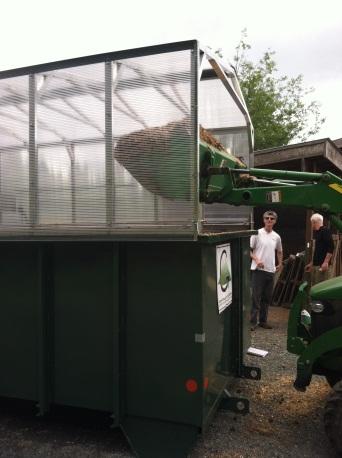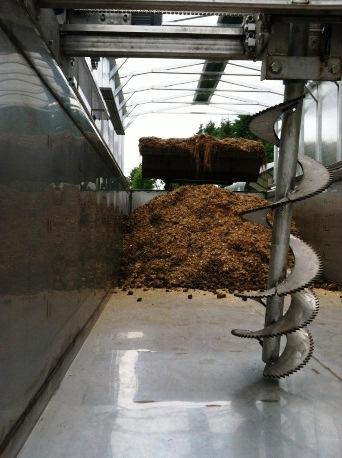![]() Waste to Worth home | More proceedings….
Waste to Worth home | More proceedings….
Abstract
Composting is becoming widely accepted as a best management practice for equine facilities. Stable waste is a readily compostable feedstock which generates heat and transforms into a finished compost product in as little as 2 weeks using in-vessel technologies. Composting the stable waste is financially beneficial, turning a liability into an asset, negating disposal fees, offering a decrease in bedding expenses and creating a saleable product. In- vessel composting allows for compliance with increasing environmental regulations associated with manure management.
The primary topic will be the cost analysis of in-vessel vs. open pile composting of stable waste. The author will also compare the value of the product produced, specifically the value added with weed seed kill, reduction of pathogens, and the uniform quality and dryness of end product. The presenter will provide lab data showing compost stability and pathogen reduction using both shavings and pellet bedding. Value of the end product is seen in bedding re-use and/or soil amendment.
Discussion of cost savings will differ for different venues in the industry. Case studies will be shown for the financial analysis of a private 20 horse stable and the 65 horse stable at the US Army base at Fort Myer/Henderson Hall in Washington DC.
|
In-Vessel Earth Flow system used for manure waste at IOS Ranch, Bainbridge Island, WA |
Why Study Composting Stable Waste?
To identify a financially beneficial way to dispose of stable waste for equine facilities.
What Did We Do?
Costs associated with the disposal of stable waste are increasing, taking a larger part of the operating budget for many barns. The increasing costs are largely due to environmental awareness and new and expanded regulations for all segments of the waste stream. Barns can no longer legally pile manure unprotected in the backyard. In many regions, haulers have to be registered and dump sites are forced to put in expensive regulation-specified collection pads. . Farms are less likely to take and store stable waste for land use and not all municipal dump sites have the infrastructure to handle the waste. Barn owners are left searching for affordable solutions.
Composting came to the forefront as a proven method to dispose of stable waste by turning a cost into a revenue stream by eliminating haul off disposal fees and creating a saleable by product with stable soil amendment. Urban locations have the added burden of odor control; also addressed with a composting system, especially with an in-vessel system. With these systems, environmental regulations are met and even exceeded. The resulting composted material can be either sold or used on site as soil amendment or for bedding reuse. If the material is sold, the infrastructure for this sales effort will need to be established.
Existing technology for composting food waste was examined to treat stable waste. The in-vessel composting systems with an automated auger and computer-controlled cycles adapted to stable waste easily. In fact one of the test sites, Joint Base Meyers/Henderson, tested the use of stable waste from the Caisson Stable as the bulking agent for the food waste from their commissary and mess halls. In a second test, the stable waste was used exclusively and proved to be a superior soil amendment that passed all laboratory testing and is currently being used at Arlington National Cemetery.
Private stables are putting in-vessel systems on site as they have small footprints, low energy consumption, low manpower hours, ease of use and comply with regulation. Medium sized barns (over 40 horses) use Site Built flow systems that have many of the same benefits as the in-vessel systems. Larger stables, event centers and high-density equine areas are looking at large scale Aerated Static Pile (ASP) yards. Cost models show these yards to be a lucrative financial investment when cost and difficulty of disposal is present as well as a market for the end product. Even when conservative numbers are used for both number of horses serviced and value of end product, ASP facilities are a good business opportunity. The investment cost for the in-vessel systems, site built systems and ASP sites vary by size and volume. In cases where the expense of haul off of the stable waste exists, the ROI for an in-vessel system illustrates a solid investment.
|
Easy loading with the front bucket of a tractor. |
Horse manure and traditional wood shavings or pellets is an excellent feedstock for composting. As explained by Michael Bryon Brown of Green Mountain Technology, “Horses are not ruminants and therefore do not extract as much nutrient from the grasses they eat. This leaves more energy available for the compost process. Typically, horse manure is collected with bedding material which is saturated in urine which has available urea and ammonia. The wood shavings are also an excellent bulking agent and carbon source for the compost process. The bedded horse manure has a high C:N ratio of 30:1 or higher. However, much of the N is in the form of ammonia which is readily available. The net effect is that if the horse manure balls are blended with the shavings before the ammonia dissipates, it will create the ideal compost matrix.”
In the auger-based systems, the horse manure is shredded and blended with the bedding, bringing the nitrogen in contact with the grass fibers. This blended material generates heat, driving off moisture as vapor. Temperatures rise to 135-155F sterilizing the compost, killing weed seed and drying the mixture. In-vessel composted material is ready to exit the system in 10-14 days; in a site-built system, depending on length of the bay, 15-25 days. The exiting material is void of any manure or ammonia smell and is homogenous in nature. Laboratory testing has shown the compost to be stable and free of pathogens according to EPA regulations. Composting stable waste reduces by up to 50% both water-soluble phosphorous and nitrogen that would be present in rain water runoff from an untreated pile.
|
Interior auger used to mix and move the stable waste material. |
The price for composted material will vary across the country in accordance with the demand for the product. In urban areas outside of Seattle, Washington, compost is selling for as much as $32 a yard at retail and $20 a yard wholesale. Untreated aged horse manure is being sold in Florida for $5 a yard. Historically barns have advertised manure for sale with an ad in the local paper, offering to fill up a pick up for a nominal sum. Initial effort will be spent to set up a network of buyers for the compost material. Once the network is set it should create a steady income stream.
Options other than soil amendment include re-use as bedding for both equine and dairy businesses, lowering another cost of operation if the compost material is priced below new shavings. Regional prices for new shavings vary by up to $8 dollars per yard and availability ranges from scarce to plentiful. Further financial gain can occur with the added health benefits to bedding re-use, long recognized in the dairy industry and recently explored in the equine industry.
What Have We Learned?
Spread sheets supporting above findings.
Future Plans
We plan to follow development and enforcement of regulations on manure waste, support networking of compost markets, continue research on the health benefits of bedding re-use and continue to develop composting systems that are affordable for the equine industry.
Authors
Mollie Bogardus, MBA in Sustainable Business, Bainbridge Graduate Institute, Equine Specialist, Green Mountain Technologies, Inc. mollie@compostingtechnology.com
Additional Information
Bogardus, Mollie. “Equine Applications – Case Studies.” Green Mountain Technologies, Inc.. N.p., 13 Sept. 2012. Web. 27 Feb. 2013. <http://compostingtechnology.com/equine>.
Brezovec, Paul. “Evaluating Composting for Contingency Bases « « BioCycle BioCycle.” Composting, Renewable Energy & Sustainability | BioCycle.net BioCycle. Version Nov 2012, Vol.53, No. 11, p. 20. Biocycle Magazine, n.d. Web. 27 Feb. 2013. <http://www.biocycle.net/2012/11/evaluating-composting-for-contingency-ba….
“Equine Applications- Media- lab results.” Green Mountain Technologies. Green Mountain Technologies, Inc, n.d. Web. 27 Feb. 2013. <http://compostingtechnology.com/equine>.
Price Youngquist, Caitlin. “Composted Manure and Stall Bedding Pilot Project | Better Ground.” Better Ground, the outreach program of Snohomish Conservation District. SARE, 13 Feb. 2013. Web. 27 Feb. 2013. <http://www.betterground.org/composted-manure-and-stall-bedding-pilot-pro….
Price, Caitlin. “Composted Manure and Stall Bedding Pilot Project | Better Ground.” Better Ground, the outreach program of Snohomish Conservation District. SARE, 26 Feb. 2013. Web. 27 Feb. 2013. <http://betterground.org/composted-manure-and-stall-bedding-pilot-project/>.
Sikora, Lawrence. “Composting Effects on Phosphorous availability in Animal Manures.” SERA-17 Organization to Minimize Phosphorous Losses from Agriculture. SERA-17, n.d. Web. 15 Jan. 2013. <www.sera17.ext.vt.edu/Document/BMP_composting_effects.pdf>.
Wheeler, Eileen. “Cornell Cooperative Extension, Orange County Equine, Saratoga County Equine.” Cornell Cooperative Extension, Orange County Equine, Saratoga County Equine. Penn State, n.d. Web. 27 Feb. 2013. <http://www.cceequine.org>.Zaborski, Ed. “Composting to Reduce Weed Seeds and Plant Pathogens – eXtension.” eXtension – Objective. Research-based. Credible.. University of Illinois at Urbana-Champaign, 22 Oct. 2012. Web. 27 Feb. 2013. <http://www.extension.org/pages/28585/composting-to-reduce-weed-seeds-and….
Acknowledgements
Special thanks to Caitlin Price Youngquist , Farm Planner, Snohomish Conservation District, for her continuing collaboration and dedicated work on this subject.
The authors are solely responsible for the content of these proceedings. The technical information does not necessarily reflect the official position of the sponsoring agencies or institutions represented by planning committee members, and inclusion and distribution herein does not constitute an endorsement of views expressed by the same. Printed materials included herein are not refereed publications. Citations should appear as follows. EXAMPLE: Authors. 2013. Title of presentation. Waste to Worth: Spreading Science and Solutions. Denver, CO. April 1-5, 2013. URL of this page. Accessed on: today’s date.




